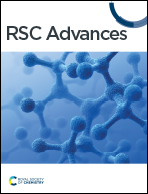Supramolecular assemblies in the molecular complexes of 4-cyanophenylboronic acid with different N-donor ligands †
Abstract
Molecular complexes of 4-cyanophenylboronic acid (CB) with various N-donor compounds having different conformational features, for example, rigid (1,10-phenanthroline (110phen), 4,7-phenanthroline (47phen), 1,7-phenanthroline (17phen) and acridine (acr)) and linear (1,2-bis(4-pyridyl)ethane (bpyea), 1,2-bis(4-pyridyl)ethene (bpyee) and 4,4′-azopyridine (azopy)), have been reported. In all complexes, the –B(OH)2 moiety is found to be in a syn–anti confirmation, with the exception of structures containing 110phen, bpyee, and azopy, wherein, syn–syn conformation is observed. Further, CB molecules remain intact in all structures except in the complexes with some linear N-donor ligands, wherein –B(OH)2 transforms to monoester (–B(OH)(OCH3)) prior to the formation of corresponding molecular complexes. In such boronic monoester complexes, the conformation of –B(OH)(OCH3) is syn–anti with respect to the –OH and –OCH3 groups. Also, complexes mediated by azopy and bpyee exist in both hydrated and anhydrous forms. In these anhydrous structures, the recognition pattern is through homomeric (juxtaposed –CN and –B(OH)2) as well as heteromeric (between hetero N-atom and –B(OH)2) O–H⋯N hydrogen bonds, while only heteromeric O–H⋯N hydrogen bonds hold co-formers in all other structures. Depending upon the conformational features of both co-formers, molecules are packed in crystal lattices in the form of stacked layers, helical chains, and crossed ribbons. All structures are fully characterized by single-crystal X-ray diffraction and phase purity is established by powder X-ray diffraction. Additionally, correlation among structures is explained by calculating a similarity index and performing a Hirshfeld surface analysis to quantify the strength and effectiveness of different types of intermolecular bonds that stabilize these structures along with the presentation of energy frameworks, representing the strength of the interactions in the form gradient cylinders. Also, the morphology of each complex was computed by BFDH methodology to correlate with the actual crystal morphology and packing arrangement.



 Please wait while we load your content...
Please wait while we load your content...